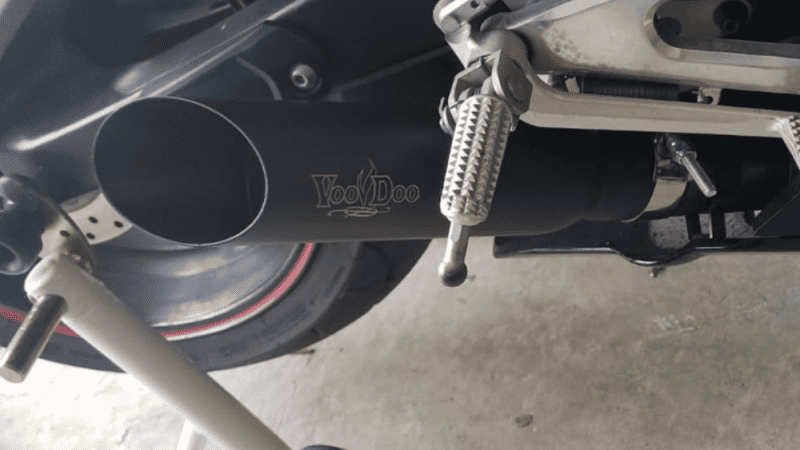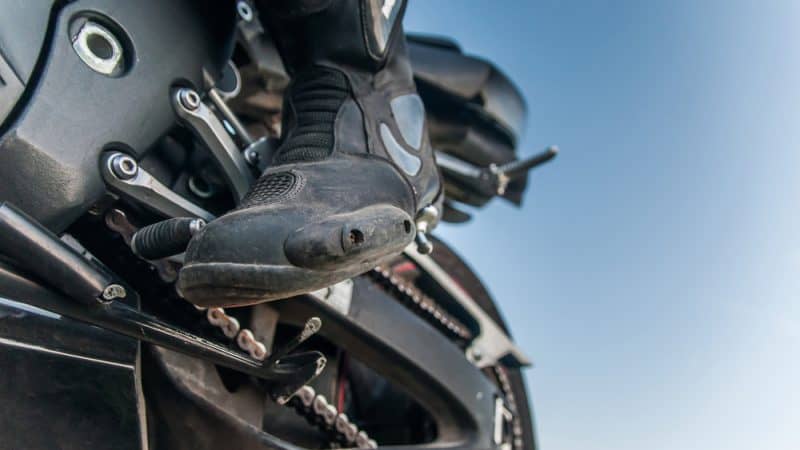What Is A Motovlog?
Simply put, motovlogging is when you attach a camera to yourself or your motorcycle and record your ride. Wikipedia defines it as:
A motovlog is a type of video log recorded by a person while riding a motorcycle. The word is a neologism and portmanteau derived from “motorcycle”, “video” and “log”. A rider who creates video blogs known as a moto blogger, and the action of making motovlogs is called motovlogging. Most motovloggers upload their videos on YouTube, and the network of motovloggers here is known as the motovloggers community.
Are you looking for motovloggers to follow?
While I’m positive this isn’t a complete list, I’m sure you’ll find a channel here that will peak your interest. Make sure you check back frequently because I’ll be adding to this list.
If you’re a motovlogger that would like to added to this list simply follow me on YouTube and fill out my contact form and I’ll get you added!
Coming Soon:
- The Ultimate List Of Motovloggers
- The Ultimate List Of Instagram Motovloggers
Shout Out To PhatboyR6 and No.Bumpers for helping me come up with this collection of motovloggers. So here they are in no particular order!
You Might also like
-
The Best Stretching Exercises for Sportbike Riders
Riding a sportbike can be an exhilarating experience, offering a sense of freedom and excitement. However, it can also be demanding on the body, particularly on the muscles and joints used most during rides. To ensure both safety and enjoyment while riding, incorporating stretching exercises into your routine is essential. Below, we outline the best stretching exercises specifically designed for sportbike riders, aiming to enhance flexibility, reduce muscle stiffness, and prevent injury.
Key Takeaways
- Stretching improves flexibility and range of motion, essential for comfortable and safe riding.
- Regular stretching can prevent muscle stiffness and soreness, particularly in areas heavily used during rides such as the wrists, shoulders, and legs.
- Incorporating exercise stretch bands can enhance stretching routines, offering resistance that can help improve overall flexibility.
Comparison Table: Stretching vs. No Stretching for Sportbike Riders
Criteria With Stretching Without Stretching Flexibility Improved Decreased Muscle Soreness Reduced Increased Injury Risk Lowered Elevated Riding Comfort Enhanced Compromised Recovery Time Shortened Lengthened Why Stretching is Crucial for Motorcycle Riders
Before delving into the specific exercises, it’s important to understand why stretching is so beneficial for motorcycle riders. Stretching can improve range of motion, decrease the risk of muscle soreness and injuries, and enhance your overall riding experience by keeping the body flexible and prepared for the demands of riding.
Best Stretches for Motorcycle Riding
- Wrist Extensor and Flexor Stretches
- Purpose: Alleviates wrist stiffness and prevents arm pump.
- How to Do: Extend your arm, palm down, and gently pull the fingers towards your body with the other hand. For the flexor stretch, extend your arm, palm up, and pull the fingers towards your body.
- Shoulder and Chest Openers
- Purpose: Opens the chest and shoulders, counteracting the forward-leaning posture.
- How to Do: Interlace your fingers behind your back, straighten your arms, and lift your chest upwards, feeling the stretch in your shoulders and chest.
- Hip Flexor Lunges
- Purpose: Loosens the hip flexors, crucial for maintaining a comfortable riding position.
- How to Do: Step forward into a lunge, keeping the back leg straight and the front leg at a 90-degree angle. Push your hips forward.
- Quadriceps Stretch
- Purpose: Stretches the front thigh muscles, which can become tight from the riding position.
- How to Do: Standing on one leg, pull the other foot towards your buttock, keeping the knees together.
- Seated Hamstring Stretch
- Purpose: Increases flexibility in the back of the legs.
- How to Do: Sit on the ground, extend your legs, and reach towards your toes.
- Glute and Piriformis Stretch
- Purpose: Relieves tightness in the buttocks and lower back.
- How to Do: Sitting on the floor, cross one leg over the other and gently pull the knee towards the opposite shoulder.
Incorporating Stretch Bands for Enhanced Flexibility
Exercise stretch bands can be a valuable tool for motorcycle riders looking to enhance their stretching routine. They provide resistance, increase the effectiveness of stretches, and help improve overall flexibility. Here are a couple of stretches using exercise bands:
- Band-Assisted Hamstring Stretch: Lie on your back, loop a band around your foot, and gently pull back, keeping the leg straight.
- Shoulder Stretch with Band: Hold a stretch band in both hands, lift your arms over your head and behind your back, stretching the shoulders.
FAQs on Stretching for Motorcycle Riding
- How often should I stretch?
- Ideally, before and after each ride to warm up and cool down the muscles.
- Can stretching improve my riding performance?
- Yes, by enhancing flexibility and reducing muscle fatigue.
- Are there stretches to prevent lower back pain from riding?
- Yes, hip flexor stretches and lower back stretches can help alleviate and prevent lower back pain.
- Why is stretching important for motorcycle riders? S
- tretching improves flexibility and reduces the risk of muscle stiffness and injuries, making riding more comfortable and enjoyable.
- How often should I stretch for the best results?
- Ideally, before and after each ride to prepare your muscles for the ride and to aid in recovery afterwards.
- Can stretching help with lower back pain from riding?
- Yes, specific stretches targeting the lower back and hip flexors can alleviate and prevent lower back pain.
- Are exercise stretch bands beneficial for riders?
- Yes, they add resistance to stretches, effectively improving flexibility and strength in key muscle groups.
- What are the best stretches for sportbike riders?
- Wrist, shoulder, hip flexor, quadriceps, hamstring, and glute stretches are highly beneficial.
- How long should each stretch be held?
- Each stretch should be held for at least 30 seconds to maximize its effectiveness.
Conclusion
Incorporating these stretching exercises into your routine can significantly enhance your motorcycle riding experience. Not only do they prepare your body for the ride, but they also help prevent post-ride stiffness and soreness. Remember, consistency is key to seeing improvements in flexibility and to enjoy a more comfortable and enjoyable ride.
For more tips on fitness and motorcycle riding, check out our Fitness Blog at RunTheCity. Whether you’re a seasoned rider or just starting, understanding and practicing these stretches can lead to a healthier, more enjoyable riding experience.
-
Everything You Need to Know About Shorty Motorcycle Exhausts
The rumble of a motorcycle engine is a sound that stirs the soul of many riders. But sometimes, the stock exhaust just doesn’t cut it. Enter shorty exhausts, a popular aftermarket modification that promises a bolder sound and a sleeker look. But are they right for you? This guide delves into everything you need to know about shorty motorcycle exhausts, helping you make an informed decision.
Key Takeaways
- Shorty exhausts, also known as slip-on exhausts, offer a sleeker look and potentially louder sound compared to stock exhausts.
- Consider increased noise levels, potential performance changes, and legal compliance before installation.
- Research specific exhaust models for your motorcycle to understand performance impact.
- Explore alternative exhaust options like full systems or baffles for additional considerations.
Comparison Table: Shorty Exhausts vs. Stock Exhausts
Feature Shorty Exhaust Stock Exhaust Appearance Sleeker, more aggressive Bulky, standard design Weight Lighter Heavier Sound Louder (may not be legal) Quieter Performance May improve or decrease (research specific model) Consistent, designed for specific motorcycle Cost Varies Usually included in the motorcycle price No products found.
What are Shorty Exhausts?
Shorty exhausts, also known as slip-on exhausts, are aftermarket mufflers that replace the stock exhaust on your motorcycle. They are significantly shorter and lighter than the factory exhaust, offering a more compact and aggressive appearance. However, it’s crucial to remember that they are often louder and may not comply with noise regulations in all areas.
Why Choose a Shorty Exhaust?
Riders choose shorty exhausts for several reasons:
- Enhanced aesthetics: Shorty exhausts can significantly improve the look of your motorcycle, giving it a more customized and aggressive appearance.
- Lighter weight: The reduced size and weight of a shorty exhaust can contribute to a slight improvement in handling and performance.
- Potentially louder sound: For some riders, the deeper and louder sound of a shorty exhaust adds to the riding experience.
No products found.
Things to Consider Before Installing a Shorty Exhaust:
While shorty exhausts offer potential benefits, there are also drawbacks to consider:
- Increased noise: As mentioned earlier, shorty exhausts are often significantly louder than stock exhausts and may not be legal in all areas. Always check local regulations before installing one.
- Potential performance changes: While some shorty exhausts can improve power delivery, others may negatively affect performance due to backpressure changes. Researching specific models and their impact on your motorcycle is crucial.
- Potential for increased heat: Due to their shorter design, shorty exhausts may direct more heat towards the rider’s legs. Consider this factor, especially for long rides or hot climates.
No products found.
Installation:
Installing a shorty exhaust can often be done at home with basic tools and mechanical knowledge. However, if you’re not comfortable doing it yourself, it’s recommended to seek professional help from a qualified mechanic. The provided reference (How To Install A Voodoo Slip-On Exhaust) offers a helpful guide on installing a specific shorty exhaust model.
The Final Verdict
Shorty exhausts offer a unique combination of style, sound, and potential performance gains for motorcycle enthusiasts. However, it’s essential to consider the potential drawbacks, such as increased noise and potential legal implications, before making a decision. Remember to prioritize safety and ensure your chosen exhaust complies with local regulations.
Additional Considerations:
- Legality: As the provided article mentions, exhaust modifications might not be legal in all areas. Always check local regulations to ensure compliance.
- Performance impact: While the article mentions potential performance changes, it’s important to note that these can vary depending on the specific motorcycle and exhaust model. Consulting a mechanic or researching specific exhausts for your motorcycle is recommended for a more accurate assessment.
- Alternatives: Shorty exhausts aren’t the only option for modifying your motorcycle’s exhaust. Consider researching other options like full exhaust systems or muffler baffles to find the best fit for your needs and preferences.
By carefully considering all the information presented here, you can make an informed decision about whether a shorty exhaust is the right choice for your motorcycle.
No products found.
6 FAQs About Shorty Exhausts
1. Will a shorty exhaust make my motorcycle faster?
Not necessarily. While some shorty exhausts can improve power delivery, others might negatively impact performance due to backpressure changes. Researching specific models and their impact on your motorcycle is crucial.
2. Are shorty exhausts street legal?
It depends on local regulations. Shorty exhausts are often louder than stock exhausts and might not comply with noise ordinances in some areas. Always check local regulations before installing one.
3. Can I install a shorty exhaust myself?
Installation can often be done at home with basic tools and mechanical knowledge. However, if you’re unsure, seek professional help from a qualified mechanic.
4. What are the alternatives to shorty exhausts?
Consider full exhaust systems for comprehensive performance upgrades or muffler baffles for a slightly modified sound without significant visual changes.
5. How much do shorty exhausts cost?
Prices vary depending on the brand, model, and material. Expect to pay more for well-known brands and high-quality materials.
6. Where can I find shorty exhausts for my motorcycle?
Many motorcycle parts retailers and online stores offer a wide variety of shorty exhausts. Ensure the chosen exhaust is compatible with your specific motorcycle model.
No products found.
-
Beginner’s Guide To Shifting Gears On A Motorcycle
An underrated aspect of learning how to ride a motorcycle goes beyond turning and popping wheelies. No, it’s something seemingly much more simple than that. Do you shift? Sure, shifting gears should be easy, because it’s a basic function; but shifting gear does have a layer of complexity that beginning cyclists could have problems mastering right away.
Here’s everything you need to know about shifting gears on a motorcycle.Motorcycle Gears Basics
The three basic controls are ones that you might already know—the throttle, the clutch, and the gear selector. You use the throttle to rev the engine, the clutch to engage and disengage the brakes (transmission), and to select gears. For instance, if you pull the left hand clutch towards you, the engine revs without ever moving the bike.
The gear pattern can be clicked through by using the gear selector lever and is moved by your left foot. Most bikes have the following gears, starting with the lowest first:
• First gear
• Neutral
• Second gear
• Third gear
• Fourth gear
• Fifth gear
• Sixth gear (depending on the bike)
As you can see, shifting fears is sequential. Up or down, neutral (N) is always put between 1st and 2nd gear.Technique For Motorcycle Shifting
It’s best to learn the proper technique required to maneuver through shifting gears before learning how to do anything else.
Steps of the proper shifting technique:- Disengage the clutch. Use your left hand to pull it towards you.
- Select the correct gear by using your left food on the shifting lever.
- Slightly rev the engine if shifting up.
- Gradually release the clutch. Don’t pop it.
- Feather the throttle while releasing the clutch to accelerate smoothly.
- Continue revving if you which to switch to another gear in succession. Otherwise, find a nice cruising speed to maintain.
Shifting With Sound and Feel
Have you ever heard wailing motorcycle engines on the road? You’ve probably thought to yourself, “Is that rider even shifting?” That’s you using the basic rule of sound. In basic terms, if an engine starts to scream, you shift to an upper gear. If the engine starts to grumble, then shift the engine lower.
There a many methods to help you do this properly. Beginners should only focus on the simplest method. Afterwards, you can experiment.
Start off by riding in first gear. Try to sense to point when you need to switch to second gear. This means the engine isn’t yet screaming, but you are feeling the natural inclination to gain more speed. The clutch will disengage easily.
Should the engine start to scream, this means you’ve hit the red line, otherwise known as the built-in limiter. The limiter is placed in the engine to ensure the bike doesn’t overextend itself and burn up.
If you shift a gear up too soon, the bike could stall or choke. Restart the bike. Try again. Keep working through the gears until you can hear and feel when it is time to gear up.Shifting Smoothly
You will notice that there’s no mathematical equation to figure out the “when” behind shifting. Every bike has a unique behavior that depends on how you handle it. For instance, if the bike jerks when you release the clutch, you’re being too abrupt. If the bike tends to lurch during shifts, you’re applying too much throttle. If the motorcycle’s speed dips during shifting, you need to rev the engine more between gear changes. Pay attention to the clutch, throttle, and gear selector, because these all interact and are dependent on one another.
Mechanics of Movement
Let’s back-up for a moment. Now that you have this idea in your mind that you need to listen and feel and understand with muscle memory what to do when shifting, it’s time to talk about what is happening inside the bike while you’re doing the actions.
The clutch is the first thing you touch when it’s time to shift gears, unless you have an automatic motorcycle or a quick shift. Once the clutch is engaged, meaning the lever is out and power is send to the rear tie, little springs press on the clutch plate that connect the primary drive to the part that rotates from the pistons going up and down.
When you pull the lever, the plate separates and releases the connection to the motor. In this moment, you can change gears.
That’s when you take your foot and move the gear selector. On the gear selector is a piece called a collar that has “dogs.” This dogs mesh together with the fork in the same way you interlace your fingers. When you move your foot up and down on the selector, the dogs and fork connect to help change the gear. Then, you find the right gear and accelerate.
Keep this in mind while reading the next two sections about upshifting and downshifting.Upshifting
Most of this article has been devoted to upshifting. Upshifting is easier than downshifting, because you are accelerating. This means that if you do any of the steps of shifting a little too quick, there’s less of an impact. Of course, this could result in a sudden jolt of power to the rear wheel, causing the front tire to come off the ground.
(Note: You should only practice stunts in a controlled environment and when you have gained enough experience.)Downshifting
On the opposite end of upshifting is downshifting, which tends to go a little less smoothly. If you release the clutch too quickly while downshifting, the sudden downward change can cause the gear to slow down the rear tire, compressing the front end, and causing a lack of traction in the back end. You need to be able to control the release of the clutch.
Be careful when rounding corners and decreasing your gears for this reason. You don’t want to suddenly lose traction right when you need more grip on the asphalt. That could cause the bike to skid to the side.False Neutral
When downshifting, you could accidentally hit a false neutral. This can happen anywhere there shouldn’t be a neutral, including between 3rd and 4th or 4th and 5th and so on. This could happen if the dogs don’t connect with the fork when selecting gears. There is power loss to the rear wheel.
If you end up in a false neutral, pull on the clutch, and put the bike into a higher gear. You can prevent excessive damage to the bike. Be quick and make sure you move into the correct once you get out of false neutral.
With that, you should be able to master the basics of shifting. Practice the timing of the clutch release and working with the gear selector for a bit. You will soon be able to shift between gears like someone who has been riding for many years.
Liked this article and want more beginner motorcycle tips? Check out my YouTube channel and don’t forget to hit that subscribe button.









You forgot MiamiAndMerch; this list is so inaccurate it’s not even funny. Some these “motovloggers” rarely posts or have view more then 15 videos
When you get a chance send the links to the motovloggers I missed so I can add them to this list. Thanks!
Defo need to add saffysprocket
Nice👍👏😊 to get the chance of bikes🚴.